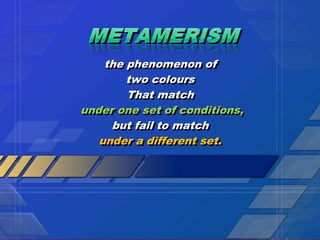
3.15 metamerism
- 1. the phenomenon of two colours That match under one set of conditions, but fail to match under a different set.
- 2. The two lights must be physically different. With coloured lights, a white light could be a mixture of approximately equal amounts of all wavelengths and could be matched by a mixture of two complementary wavelengths.
- 3. With surface colours, a sample dyed with a given set of dyes could be matched, under certain conditions, with a sample dyed with different dyes. In each case the match would be physically different, and the match would fail to hold when the conditions changed. For the white light a match for one observer would probably not be accepted as a match by a second observer.
- 4. For the dyed samples, the match would probably not hold if the light source were to be changed; the match might be satisfactory in daylight, for example, but very poor under fluorescent light. Again, a good match for one observer might be perceived as unsatisfactory by a second.
- 5. Suppose we have two objects whose tristimulus values (for a specified standard illuminant and standard observer) are identical. The two objects illuminated by the specified source and viewed by the specified standard observer would look identical, yet their reflectance curves might differ significantly.
- 6. For example, one object could have constant R values of, say, 30% at all wavelengths (and would look grey under all normal conditions), while the other object could be a piece of nylon dyed to match the first using a mixture of yellow, red and blue dyes. We can generally produce any particular grey colour using such a mixture of dyes, but it is likely that the R values will vary with wavelength. (The lowest R values would probably be found at the wavelengths of maximum absorption for each dye, say 450, 520 and 620 nm respectively.)
- 7. We can match most coloured objects (under specified conditions) using a mixture of three suitable dyes, but the reflectance curve of the dyed fabric will not be the same as that of the object to be matched. In these cases the dyeing will normally not match the target colour if the conditions are changed, and the two samples are said to be metameric, or to form a metameric pair. In terms of colour measurements, the two samples have the same tristimulus values for a specific combination of illuminant and observer, but the reflectance curves are different. Usually such pairs of reflectance curves cross at least three times.
- 8. In calculating the tristimulus values the effects of higher R values for the dyeing at some wavelengths must be balanced by the effects of lower R values at other wavelengths. If the illuminant used in the calculation is changed, not surprisingly The tristimulus values will usually change as well. This is also true if the observer is changed.
